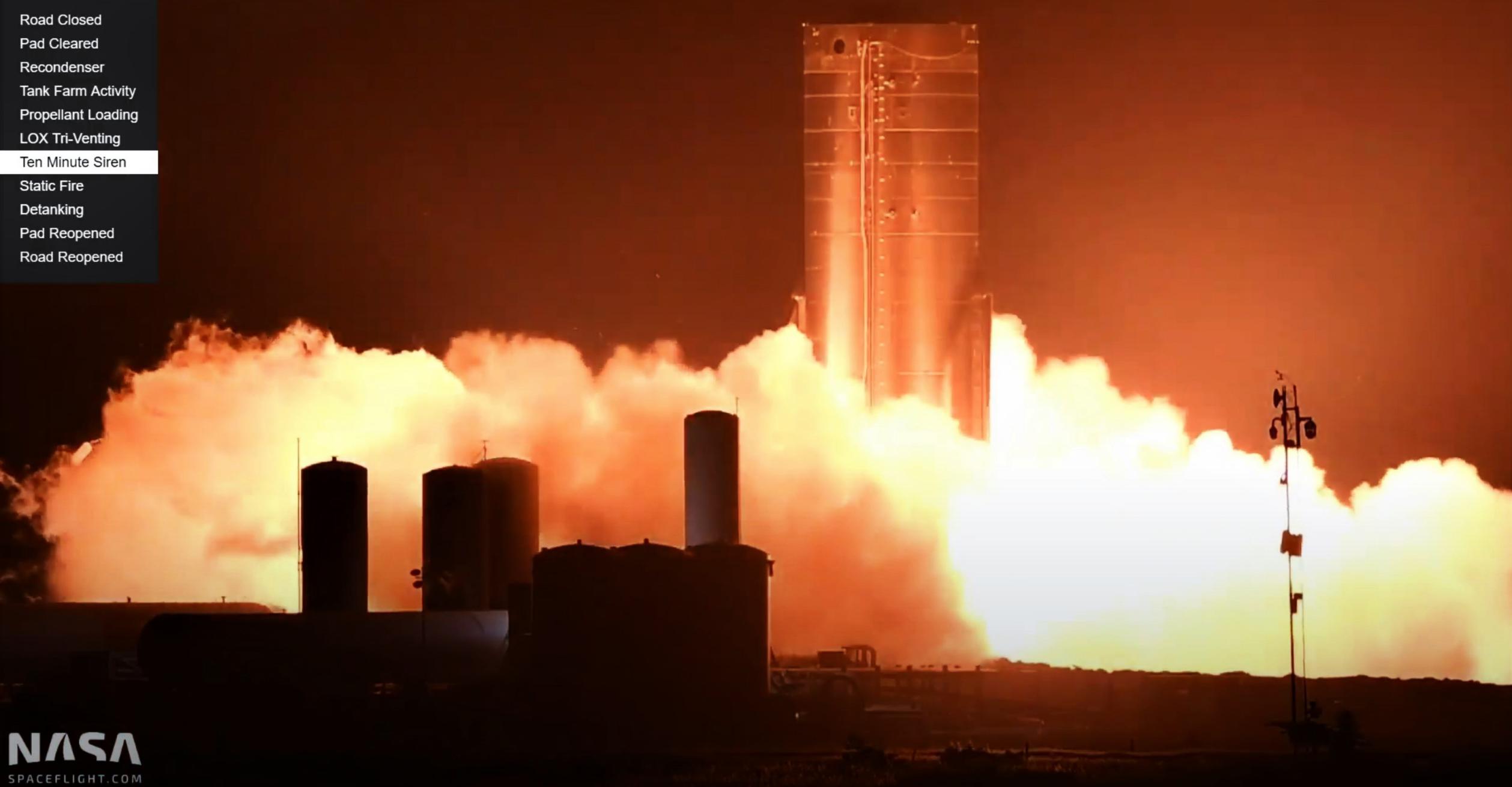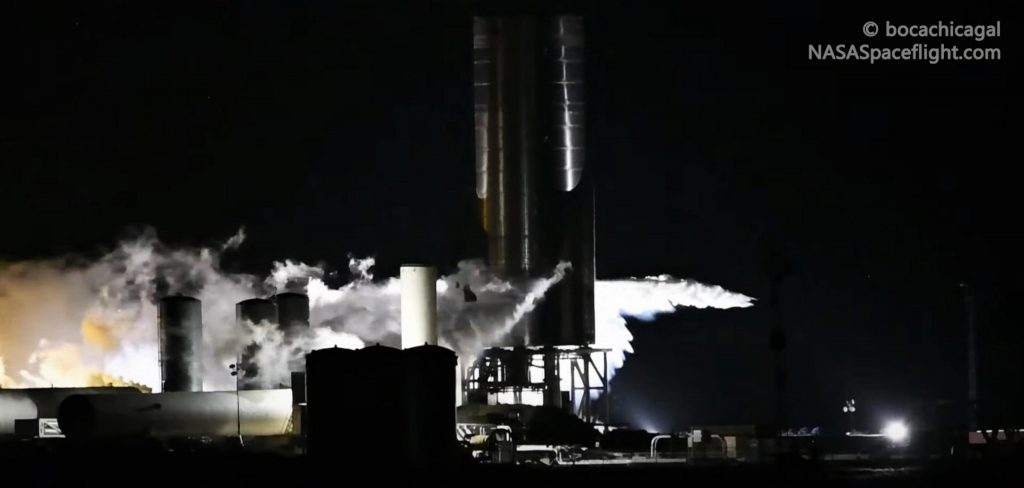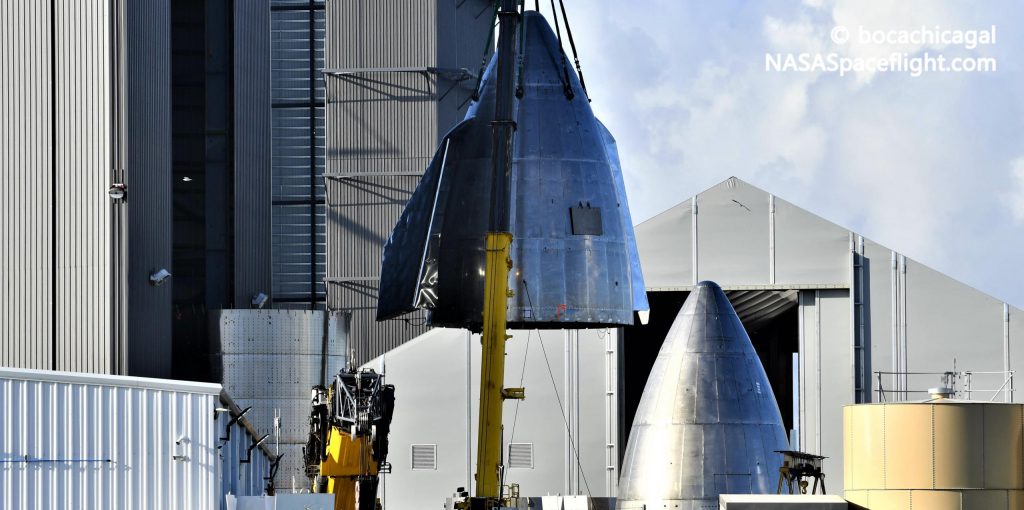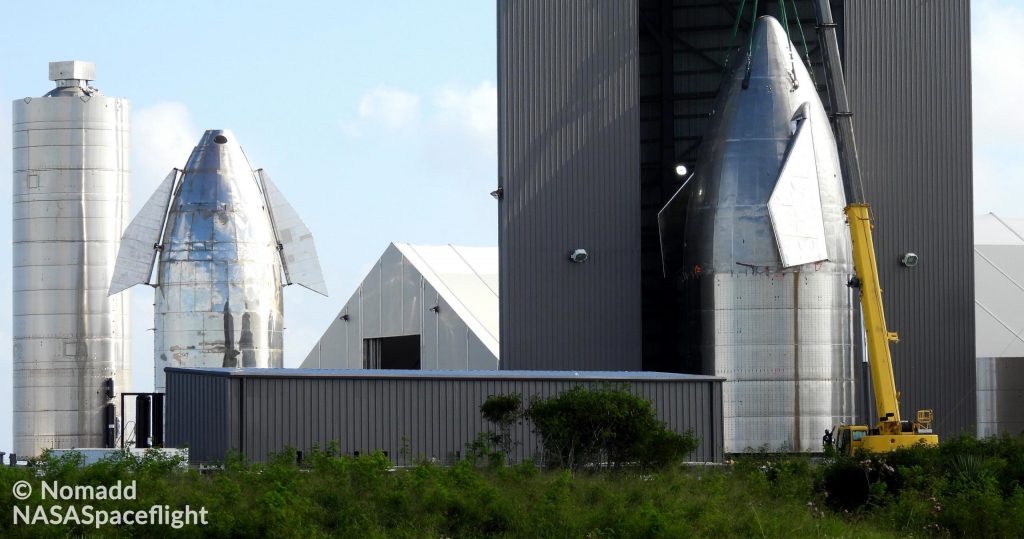

News
SpaceX Starship fires up three Raptor engines in prelude to high-altitude flight
Update: At 1:21am CDT (6:21 UTC) on October 20th, Starship SN8 ignited all three of its Raptors’ preburners, producing a spectacular fireball noticeably larger than the one produced during the rocket’s first October 19th preburner test. A mere two hours later, with no break in between, the steel rocket prototype fully ignited all three Raptor engines for the first time ever, likely producing thrust equivalent to ~90% of a nine engine Falcon 9 booster for a brief moment.
Crucially, aside from physically demonstrating Raptor’s multi-engine capabilities, Starship SN8 – already a first-of-a-kind prototype – completed and survived a static fire seemingly unscathed on its first attempt. If the data SpaceX gathers from the milestone is as good as the test appeared to be, the company could be just a few days away from installing Starship SN8’s recently-stacked nosecone, followed by a second triple-Raptor static fire test. If that second static fire goes well, SN8’s next task will be the first high-altitude Starship flight test.
Minutes after an adjacent highway was scheduled to reopen, SpaceX’s first high-altitude Starship prototype – serial number 8 – attempted what was likely the first multi-engine Raptor test ever.
At 6:01 am, October 19th, Starship SN8’s trio of Raptor engines were barely unleashed, producing a large fireball indicative of a ‘preburner’ ignition test. One of the most complex rocket engines ever developed, Raptor relies on a maximally efficient but temperamental “full-flow staged combustion” cycle (FFSC), a concise name for the many, many steps required to turn liquid propellant into thrust.
Adding additional difficulty, Raptor’s full-flow staged combustion necessitates ignition of gaseous oxygen and methane in the combustion chamber. Given that the Raptor-powered Starship spacecraft and Super Heavy booster exclusively use cryogenic liquid methane and oxygen, a major challenge posed by FFSC is the need to efficiently turn that ultra-cold propellant into hot gas almost instantaneously. This is where gas generators (or preburners) come in.
In a full-flow staged combustion engine, both oxidizer and fuel require their own separate turbopumps, which then require their own preburners to create the pressures needed to power those turbopumps and the gas the combustion chamber ignites to produce thrust. A step further, to enable high combustion chamber pressure like Raptor’s 300+ bar (~4400+ psi), those preburners need to produce gas at far higher pressures to account for energy losses as those gases wind their way through the engine’s plumbing.
As a result, preburners are possibly the single most stressed system in an engine like Raptor. Unsurprisingly, this has often lead SpaceX to separately test each engine’s preburners as a sort of partial static fire before the actual engine ignition test. This is the test Starship SN8 attempted in the early morning on October 19th, representing Raptor’s very first multi-engine ignition event.


Curiously, moments before preburner ignition, one of the three Raptor engines appeared to command an aggressive jet-like vent of liquid oxygen identical to a vent seen just a few hours prior during the first aborted preburner test. There’s thus a chance that only two of SN8’s three Raptor engines successfully started their preburners
Raptor is the first FFSC engine in the world to fly and – as far as the duration of lifetime testing and volume production goes – is almost certainly the most advanced of the three FFSC programs to graduate to static fire tests. In other words, given that SN8’s test campaign is the first time SpaceX has ever attempted to operate multiple adjacent Raptor engines at the same time, it’s not a huge surprise that progress towards the first three-engine static fire has been cautious and halting. Mirroring its Sunday/Monday testing, SpaceX will put Starship SN8 through another preburner and/or static fire attempt between 9pm and 6am CDT (UTC-5) on October 19/20. Even more 9-6 test windows are scheduled on October 21st and 22nd.


Meanwhile, not long after Starship SN8’s first preburner test was completed, SpaceX teams rolled a section of five steel rings inside a small windbreak and stacked the first truly functional nosecone – already outfitted with forward flaps – atop it. If Starship SN8 survives its first full triple-Raptor preburner and static fire tests, that new nosecone will likely be rolled to the launch pad for in-situ installation, topping off the rocket ahead of a spectacular 15 km (~50,000 ft) flight test.

News
Tesla launches in India with Model Y, showing pricing will be biggest challenge
Tesla finally got its Model Y launched in India, but it will surely come at a price for consumers.

Tesla has officially launched in India following years of delays, as it brought its Model Y to the market for the first time on Tuesday.
However, the launch showed that pricing is going to be its biggest challenge. The all-electric Model Y is priced significantly higher than in other major markets in which Tesla operates.
On Tuesday, Tesla’s Model Y went up for sale for 59,89,000 rupees for the Rear-Wheel Drive configuration, while the Long Range Rear-Wheel Drive was priced at 67,89,000.
This equates to $69,686 for the RWD and $78,994 for the Long Range RWD, a substantial markup compared to what these cars sell for in the United States.
🚨 Here’s the difference in price for the Tesla Model Y in the U.S. compared to India.
🚨 59,89,000 is $69,686
🚨 67,89,000 is $78,994 pic.twitter.com/7EUzyWLcED— TESLARATI (@Teslarati) July 15, 2025
Deliveries are currently scheduled for the third quarter, and it will be interesting to see how many units they can sell in the market at this price point.
The price includes tariffs and additional fees that are applied by the Indian government, which has aimed to work with foreign automakers to come to terms on lower duties that increase vehicle cost.
Tesla Model Y seen testing under wraps in India ahead of launch
There is a chance that these duties will be removed, which would create a more stable and affordable pricing model for Tesla in the future. President Trump and Indian Prime Minister Narendra Modi continue to iron out those details.
Maharashtra Chief Minister Devendra Fadnavis said to reporters outside the company’s new outlet in the region (via Reuters):
“In the future, we wish to see R&D and manufacturing done in India, and I am sure at an appropriate stage, Tesla will think about it.”
It appears to be eerily similar to the same “game of chicken” Tesla played with Indian government officials for the past few years. Tesla has always wanted to enter India, but was unable to do so due to these import duties.
India wanted Tesla to commit to building a Gigafactory in the country, but Tesla wanted to test demand first.
It seems this could be that demand test, and the duties are going to have a significant impact on what demand will actually be.
Elon Musk
Tesla ups Robotaxi fare price to another comical figure with service area expansion
Tesla upped its fare price for a Robotaxi ride from $4.20 to, you guessed it, $6.90.

Tesla has upped its fare price for the Robotaxi platform in Austin for the first time since its launch on June 22. The increase came on the same day that Tesla expanded its Service Area for the Robotaxi ride-hailing service, offering rides to a broader portion of the city.
The price is up from $4.20, a figure that many Tesla fans will find amusing, considering CEO Elon Musk has used that number, as well as ’69,’ as a light-hearted attempt at comedy over the past several years.
Musk confirmed yesterday that Tesla would up the price per ride from that $4.20 point to $6.90. Are we really surprised that is what the company decided on, as the expansion of the Service Area also took effect on Monday?
But the price is now a princely $6.90, as foretold in the prophecy 😂
— Elon Musk (@elonmusk) July 14, 2025
The Service Area expansion was also somewhat of a joke too, especially considering the shape of the new region where the driverless service can travel.
I wrote yesterday about how it might be funny, but in reality, it is more of a message to competitors that Tesla can expand in Austin wherever it wants at any time.
Tesla’s Robotaxi expansion wasn’t a joke, it was a warning to competitors
It was only a matter of time before the Robotaxi platform would subject riders to a higher, flat fee for a ride. This is primarily due to two reasons: the size of the access program is increasing, and, more importantly, the service area is expanding in size.
Tesla has already surpassed Waymo in Austin in terms of its service area, which is roughly five square miles larger. Waymo launched driverless rides to the public back in March, while Tesla’s just became available to a small group in June. Tesla has already expanded it, allowing new members to hail a ride from a driverless Model Y nearly every day.
The Robotaxi app is also becoming more robust as Tesla is adding new features with updates. It has already been updated on two occasions, with the most recent improvements being rolled out yesterday.
Tesla updates Robotaxi app with several big changes, including wider service area
News
Tesla Model Y and Model 3 dominate U.S. EV sales despite headwinds
Tesla’s two mainstream vehicles accounted for more than 40% of all EVs sold in the United States in Q2 2025.

Tesla’s Model Y and Model 3 remained the top-selling electric vehicles in the U.S. during Q2 2025, even as the broader EV market dipped 6.3% year-over-year.
The Model Y logged 86,120 units sold, followed by the Model 3 at 48,803. This means that Tesla’s two mainstream vehicles accounted for 43% of all EVs sold in the United States during the second quarter, as per data from Cox Automotive.
Tesla leads amid tax credit uncertainty and a tough first half
Tesla’s performance in Q2 is notable given a series of hurdles earlier in the year. The company temporarily paused Model Y deliveries in Q1 as it transitioned to the production of the new Model Y, and its retail presence was hit by protests and vandalism tied to political backlash against CEO Elon Musk. The fallout carried into Q2, yet Tesla’s two mass-market vehicles still outsold the next eight EVs combined.
Q2 marked just the third-ever YoY decline in quarterly EV sales, totaling 310,839 units. Electric vehicle sales, however, were still up 4.9% from Q1 and reached a record 607,089 units in the first half of 2025. Analysts also expect a surge in Q3 as buyers rush to qualify for federal EV tax credits before they expire on October 1, Cox Automotive noted in a post.
Legacy rivals gain ground, but Tesla holds its commanding lead
General Motors more than doubled its EV volume in the first half of 2025, selling over 78,000 units and boosting its EV market share to 12.9%. Chevrolet became the second-best-selling EV brand, pushing GM past Ford and Hyundai. Tesla, however, still retained a commanding 44.7% electric vehicle market share despite a 12% drop in in Q2 revenue, following a decline of almost 9% in Q1.
Incentives reached record highs in Q2, averaging 14.8% of transaction prices, roughly $8,500 per vehicle. As government support winds down, the used EV market is also gaining momentum, with over 100,000 used EVs sold in Q2.
Q2 2025 Kelley Blue Book EV Sales Report by Simon Alvarez on Scribd
-

 News3 days ago
News3 days agoTesla debuts hands-free Grok AI with update 2025.26: What you need to know
-

 Elon Musk1 week ago
Elon Musk1 week agoElon Musk confirms Grok 4 launch on July 9 with livestream event
-

 Elon Musk5 days ago
Elon Musk5 days agoxAI launches Grok 4 with new $300/month SuperGrok Heavy subscription
-

 News2 weeks ago
News2 weeks agoTesla Model 3 ranks as the safest new car in Europe for 2025, per Euro NCAP tests
-

 Elon Musk2 weeks ago
Elon Musk2 weeks agoxAI’s Memphis data center receives air permit despite community criticism
-

 News5 days ago
News5 days agoTesla begins Robotaxi certification push in Arizona: report
-

 Elon Musk2 weeks ago
Elon Musk2 weeks agoTesla reveals it is using AI to make factories more sustainable: here’s how
-

 Elon Musk2 weeks ago
Elon Musk2 weeks agoTesla scrambles after Musk sidekick exit, CEO takes over sales
















